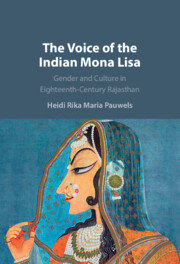
- Publisher:
- Cambridge University Press
- Online publication date:
- August 2023
- Print publication year:
- 2023
- Online ISBN:
- 9781009201698
- Subjects:
- Area Studies, South Asian History, Asian Studies, History

The 'Indian Mona Lisa' is an eighteenth-century portrait of the goddess Radha from the Kishangarh school of Rajput Painting. It was purportedly modelled after a young enslaved woman and court-performer, Banī-ṭhanī, who became a concubine of the patron of the painting, crown-prince Savant Singh. Tracing her career, Heidi Pauwels recovers her role as a composer of devotional songs in multiple registers of Classical Hindi and shows how she was a conduit for trend-setting styles from Delhi, including the new vogue of Urdu. Through a combination of literary, historical, and art-historical analysis, she brings to life the vibrant cultural production center of Kishangarh in the eighteenth century by reconstructing how Banī-ṭhanī came to be acclaimed as the devotional poetess Rasikbihārī and as 'India's Mona Lisa'. This major new study conveys important new insights in the history of Hindi literature and devotion, the family, palace women and the social mobility of the enslaved.
‘Until this study the literary and cultural contributions of Rasikbihari, consort of the poet-prince Nagaridas at the court of Kishangarh, were little known. Heidi Pauwels brings this important figure to light, exploring her role as author, her life in the zenana, and her idealization in Kishangarh poetry and imagery.’
Navina Haidar - Metropolitan Museum of Art, New York
‘This book is a tribute across the centuries from one accomplished aesthete to another. Here Heidi Pauwels, the foremost scholar of literary studies relating to the court of Kishangarh in our day, introduces us to every facet of Bani Thani, the slave, courtesan, singer, and poet who captured the heart of Maharaja Savant Singh in the mid-seventeenth century. It’s a fascinating story, and a masterpiece.’
John Stratton Hawley - Barnard College, Columbia University
‘How far can instantiations of aesthetic ideals and literary conventions be interpreted as hearkening back to actual circumstances of life? This essential issue is addressed astutely in the literary study of the Hindi-Urdu poetess Rasikbihārī, concubine of, and partner in a life-long literary and religious dialogue with, the poet-king Nāgarīdās.’
Monika Horstmann - University of Heidelberg
 Loading metrics...
Loading metrics...
* Views captured on Cambridge Core between #date#. This data will be updated every 24 hours.
Usage data cannot currently be displayed.